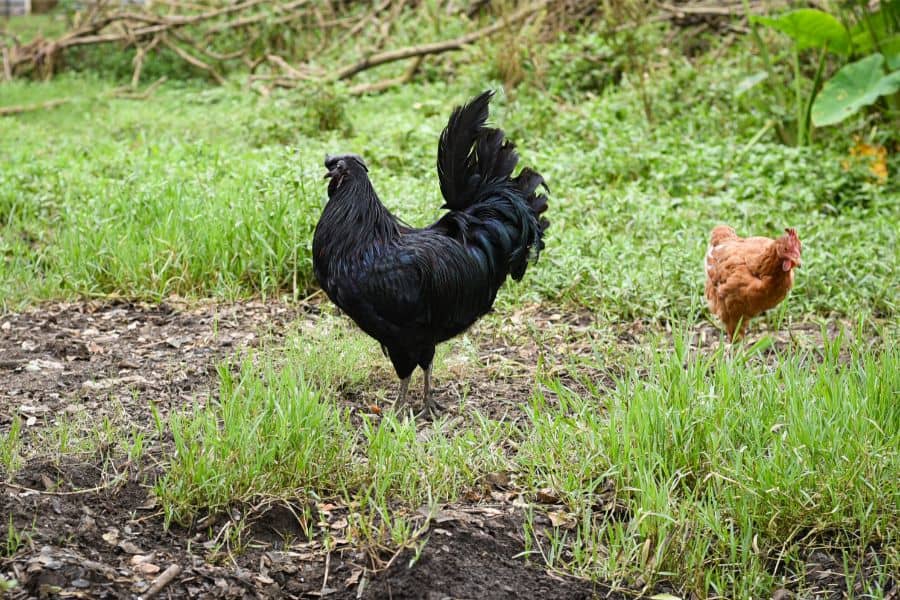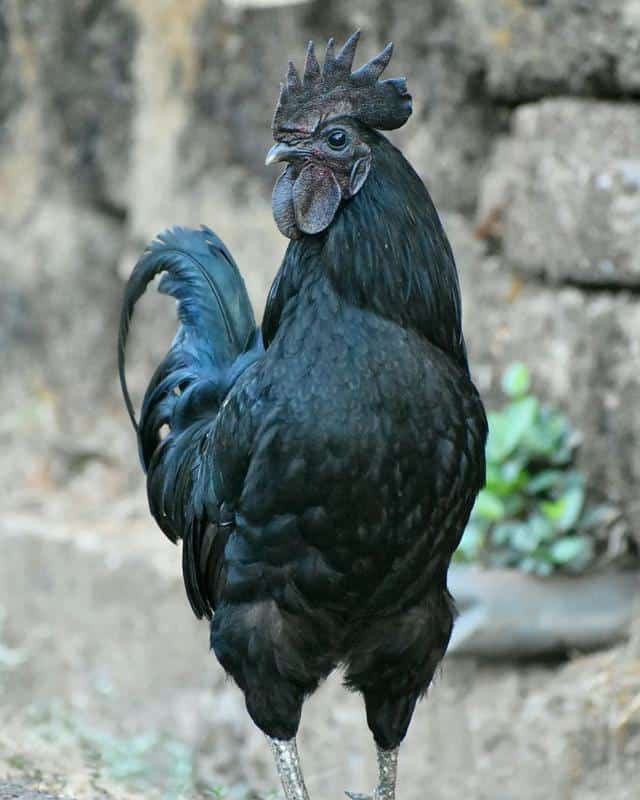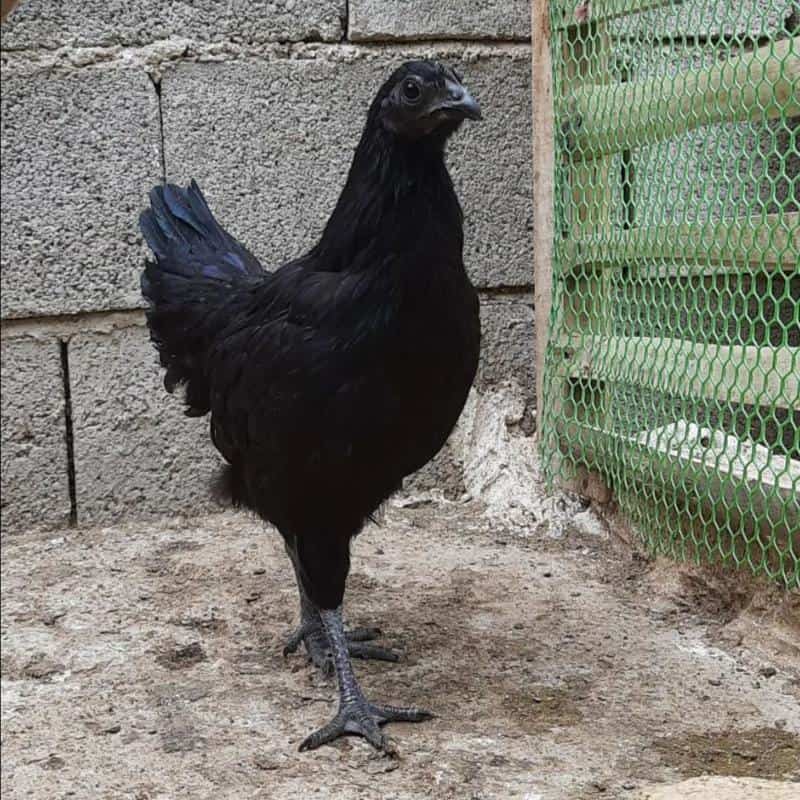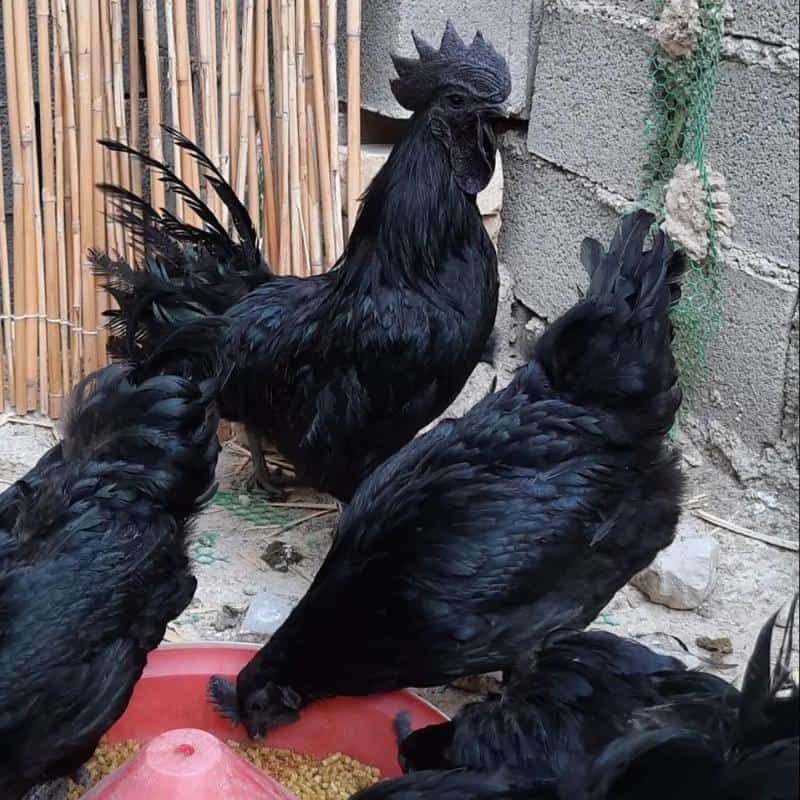Kadaknath chickens have attained an almost mythical reputation in the parts of India they originate from. This is largely attributed to a unique characteristic of their appearance, one that is extremely rare in chickens.
Although their existence had not garnered much attention before, they have come to the world’s attention in a big way in the past two decades. This has resulted in a wave of demand that has been almost unsustainable.
More farmers have been looking to add Kadaknath chickens to their flocks in recent years. However, many have found their efforts hampered by their geographic location, the high price tags attached to the chickens, and scammers.

The production potential of Kadaknath chickens is not impressive but the chickens, their meat, and eggs still command premium prices in the market. We explore whether these unique chickens live up to the hype.
Kadaknath Chicken Quick Facts
| Names | Kadaknath, Kali Masi, Black Chicken,
Black Gold, Pride of Jhabua |
| Origin | Madhya Pradesh, India |
| Purpose | Eggs and Black Meat |
| Egg Production/Year | 120 – 140 |
| Climate | Heat Hardy |
| Plumage Colors | Jet Black, Golden, Penciled |
| Weight | Hens: 3.3 lbs.
Roosters: 4.4 lbs. |
| Personality | Calm |
| Unique Fact | These chickens are black down to the internal organs and bones. |
The History of Kadaknath Chickens
Origins
Kadaknath chickens originated from India and that is still the hub of farming and consumption of these chickens. These chickens are specifically said to have originated from the Madhya Pradesh state in India, specifically in the Jhabua and Dhar regions.
It is said the chickens started out in Jhabua’s Kathiwar Alirajapur jungles. Even in the early 1800s, this chicken breed was still being hunted as game in these forests, according to some reports.
The breed became harder to find later and in 1978, Madhya Pradesh launched a landmark program to conserve the breed by setting up a farm dedicated to rearing Kadaknath chickens.
GI Status
The conservation attempt in Madhya Pradesh was a success but the breed also gained a new significance in the neighboring Chhattisgarh State. This would lead to both states laying claim to the ownership of the Kadaknath.
The two states applied for a Geographical Indication (GI) tag, which could give Kadaknath chickens from the winning region a greater value in the market. In the end, Madhya Pradesh was awarded the tag.
Appearance

Black to the Bone
Kadaknath chickens have the distinct characteristic of being entirely black. Every part of the chicken, i.e., the meat, bones, tongue, wattles, comb, legs, and internal organs is some shade of black.
This black color comes about because these chickens accumulate excess amounts of melanin in their bodies. The melanin accumulation is so significant that even the Kadaknath’s blood shows the grey-black coloration.
Plumage Variations
Although black with a green sheen is the color that is mainly seen on Kadaknaths’ plumages, there are actually three different plumage variations. These are:
- Jet black
- Penciled
- Golden
Size
Kadaknath’s are relatively small birds with the males reaching a maximum weight of approximately 4.4 pounds. Then hens will weigh around 3.3 pounds when mature.
Production Potential of Kadaknaths
Meat
The black meat of Kadaknaths is what appeals to most consumers who go looking for this bird.
The demand for this chicken’s meat has shot up in recent years. Anyone selling Kadaknath meat can get paid as much as three times what is paid for commercial broilers.
The premium price tag is important because Kadaknath chickens have a lower body weight compared to other popular breeds.
Additionally, while it takes a typical broiler 5 or 6 weeks to attain a live body weight of 4.4 pounds, Kadaknaths require 24 to 28 weeks to reach the same weight.
This means that farmers pay more for these birds, but also must spend more money feeding them for an extended period until they attain market weight.
Eggs
A surge in the popularity of Kadaknath eggs has followed the rise in the popularity of its meat. These chickens are hardly prolific layers, and a hen will typically lay around 120 to 140 eggs per year.
The eggs from Kadaknath hens are also small, averaging between 35 grams (1.23 oz) and 44 grams (1.55 oz).
It may have been interesting if Kadaknath chicken eggs were also black, but these eggs are in fact brown with a pink hue. This can make them indistinguishable from eggs from other chickens.
Despite the low yield per hen and the small sizes of the eggs, farmers can still get a good return from Kadaknath eggs due to their higher market value compared to regular eggs.
What are the Health Benefits of Kadaknath Chicken Meat?
Perhaps due to their unique appearance in the world of chickens, Kadaknath meat is claimed to have many health benefits. Some of these claimed health benefits include:
- Increasing virility in men
- Improving fertility in women
- Increasing hemoglobin content in the blood
- Reducing chronic fatigue
- Alleviating migraines
- Reducing kidney inflammation, etc.
In the absence of notable clinical studies, it is not possible to conclusively prove or disprove such claims.
Such perceived benefits could be due to other factors but it’s also possible that some individuals are simply looking to profit from the Kadaknath’s unusual appearance.
On the other hand, the actual nutritional profile of Kadaknath chickens points to the meat being healthier than that of commercial broilers. Compared to regular chicken meat, the meat from Kadaknaths has qualities such as:
- Higher protein content
- Lower fat content
- Lower moisture
- Lower ash
- Higher amino acid content
- Higher content of taste-enhancing amino acids
Some of the health benefits of Kadaknath chickens are a long way from being proven. However, the nutritional profile gives some merit to the claim that the meat from these chickens is generally healthier than that of commercial broilers.
Kadaknath Egg Benefits

Not to be left behind in this debate, there have also been claims that the eggs from Kadaknath chickens have certain health benefits. These include treatment of:
- Nephritis
- Asthma
- Severe headaches
- Faintness
As with the health claims regarding meat from Kadaknath chickens, these claims are best taken with a pinch of salt. While its consumers hold it in high regard, there is still insufficient evidence to back these claims.
It is reported that eggs from Kadaknath chickens have smaller yolks relative to the size of the eggs. For those looking to eat less cholesterol, this could mean there is some benefit in eating these eggs compared to regular ones.
Since little information is currently available on the nutritional profile of these eggs, it is difficult to ascertain how much healthier they are.
Rearing Kadaknath Chickens
Housing and Environment
When many of their chicken cousins were already being reared in people’s homesteads, Kadaknath chickens were still being hunted out in the jungles of Madhya Pradesh. This alone should tell you that these chickens are built to withstand tough conditions.
Kadaknaths can thrive in environments with extreme heat since temperatures in their native area can reach averages of 43°C. They are also said to be able to withstand cold temperatures.
Although the birds can survive in harsh environments, you can get improved results if you offer:
- A raised shelter that can offer protection from the elements. Raising the shelter is important where rainwater and flooding can be an issue.
- Noise-free environment as too much noise can affect the production of the chickens.
- An environment far from smoke-producing factories.
- Lots of space as these birds love to free range and free-range birds are what attract the high prices.
- A clean and spacious coop to limit the occurrence and spread of diseases, although these chickens are also quite resistant to certain diseases.
Check out the flock of Kadaknath chickens being reared on a large property.
Diet
Thanks to their wild origins, Kadaknath chickens are incredibly hardy and can live just by foraging for their food. However, farmers are today shifting to commercial feeds to improve the productivity of their chickens.
Due to the emphasis on meat production, broiler feed is what farmers will typically go for when raising Kadaknaths. The chickens can also supplement their diets with grass, seeds, leafy vegetables, and other kitchen scraps.
As with all chickens, especially those that free range, your Kadaknath should have free access to clean drinking water.
Breeding and Brooding in Kadaknath Chickens
One challenge in breeding these chickens is that hatching chicks will require the use of an incubator. Kadaknath hens are not known for going broody and in their native Madhya Pradesh, there are hatcheries for this purpose that are run by the government.
On the upside, the eggs have a hatchability rate of between 83 and 90 percent which is good. The quality of the shells is also good.
Getting pure-bred Kadaknath chickens outside the Jhabua region is said to be a challenge. Even within India, the chickens found in adjoining areas are said to have been extensively crossed with other breeds.
Taste Profile of Kadaknath Chicken Meat

With so much hype surrounding the unusual-looking meat of the Kadaknath chicken, perhaps the most important question is, what does it taste like?
The meat of the Kadaknath chicken is said to take on a flavor that is gamey. Some say that its taste is much more subtle compared to that of regular chicken but with gravy that has a strong and lingering flavor.
There are many different recipes that can show you how to best prepare this chicken. If you can get past how different it looks compared to other chickens you have tried in the past, you may discover why so many swear by it.
Scams Involving Kadaknath Chickens
The high value of Kadaknath chickens has attracted both enthusiasts and scammers. Many people have been keen to benefit from the unique reputation of this bird and this surge in popularity along with limited supply has attracted some unsavory characters.
In one major case, farmers in India lost more than $360, 000 to one company. The number of affected farmers was claimed to be in the hundreds and possibly thousands.
Also Read:
Not Your Regular Backyard Chicken
Although certain aspects of the Kadaknath chicken’s story seem to stretch the truth, there is no denying that these chickens are special.
These chickens are not as productive as regular chickens in terms of both meat and eggs. However, the special characteristics of their meat and eggs give them significantly higher values in the market.
Although many health benefits of eating Kadaknaths are yet to be proven, there are indications their meat is healthier than that of commercial broilers. Many would also argue that its flavor profile is far superior.
It may be a challenge to get your hands on a true breed Kadaknath outside of India, or even outside the state of Madhya Pradesh. However, if you were looking for a special chicken breed, this one checks all the boxes.
